Innovation Production: Small Firms vs. Large Firms Essay Analysis
VerifiedAdded on 2022/11/10
|13
|3013
|149
Essay
AI Summary
This essay critically examines the statement that "small firms are more likely to produce major innovations than large firms." It begins by defining innovation and its measurement, then analyzes the relative advantages and disadvantages of small and large firms in innovation production. The essay explores factors such as resource allocation, risk tolerance, organizational structure, and access to finance. It reviews existing research, including studies from various countries and sectors, to assess the validity of the statement. The findings indicate that while smaller firms may have advantages in terms of agility and risk acceptance, larger firms often possess greater resources, diversified risk portfolios, and established infrastructure. The essay concludes that larger firms may hold a slight advantage in innovation production and successful implementation, thus challenging the initial statement. The essay also includes a table summarizing the reviewed literature and its limitations.
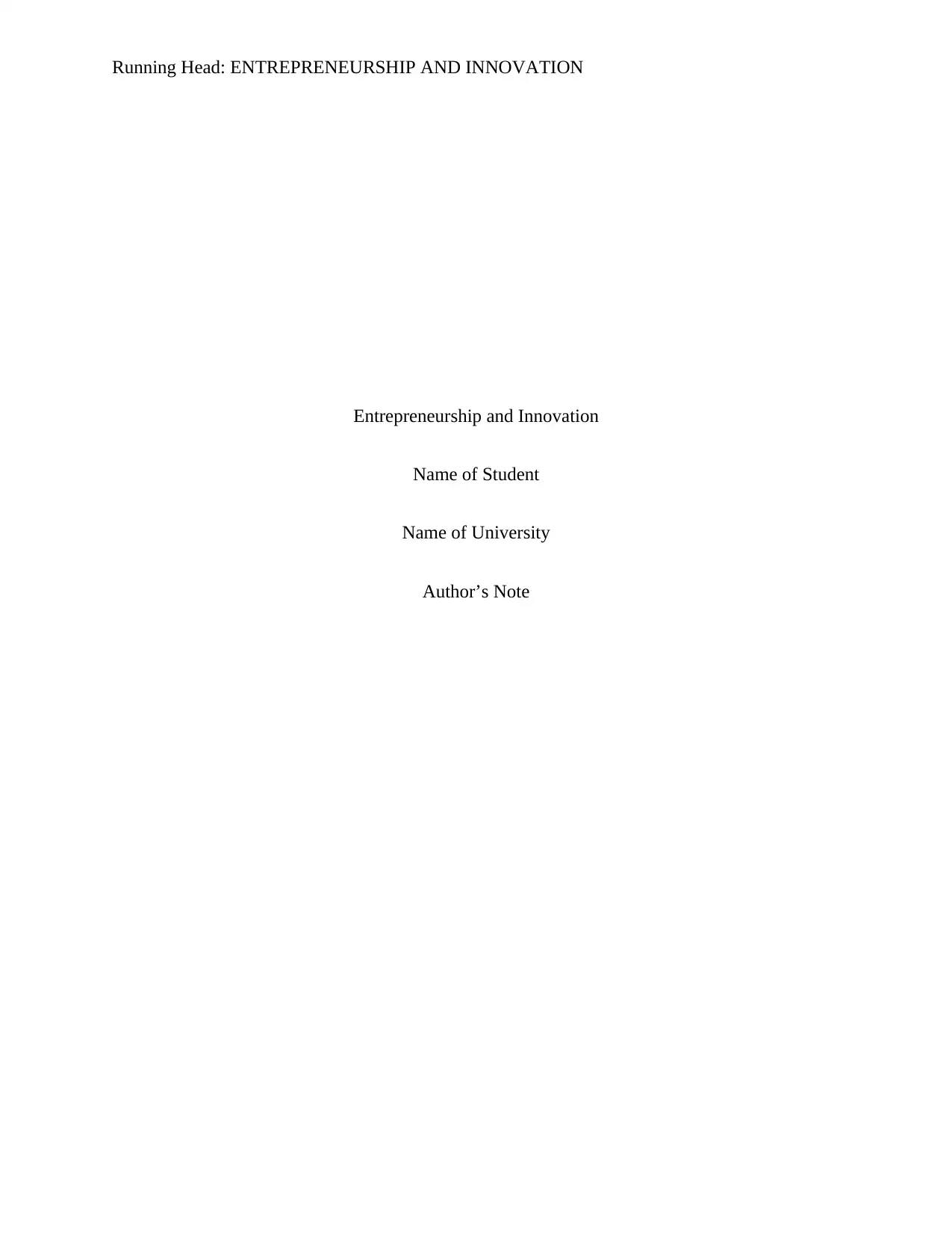
Running Head: ENTREPRENEURSHIP AND INNOVATION
Entrepreneurship and Innovation
Name of Student
Name of University
Author’s Note
Entrepreneurship and Innovation
Name of Student
Name of University
Author’s Note
Paraphrase This Document
Need a fresh take? Get an instant paraphrase of this document with our AI Paraphraser

1
ENTREPRENEURSHIP AND INNOVATION
Table of Contents
Introduction......................................................................................................................................2
Focus statement...............................................................................................................................2
Measuring Innovation......................................................................................................................2
Main Findings..................................................................................................................................5
Conclusion.......................................................................................................................................7
References:....................................................................................................................................11
ENTREPRENEURSHIP AND INNOVATION
Table of Contents
Introduction......................................................................................................................................2
Focus statement...............................................................................................................................2
Measuring Innovation......................................................................................................................2
Main Findings..................................................................................................................................5
Conclusion.......................................................................................................................................7
References:....................................................................................................................................11
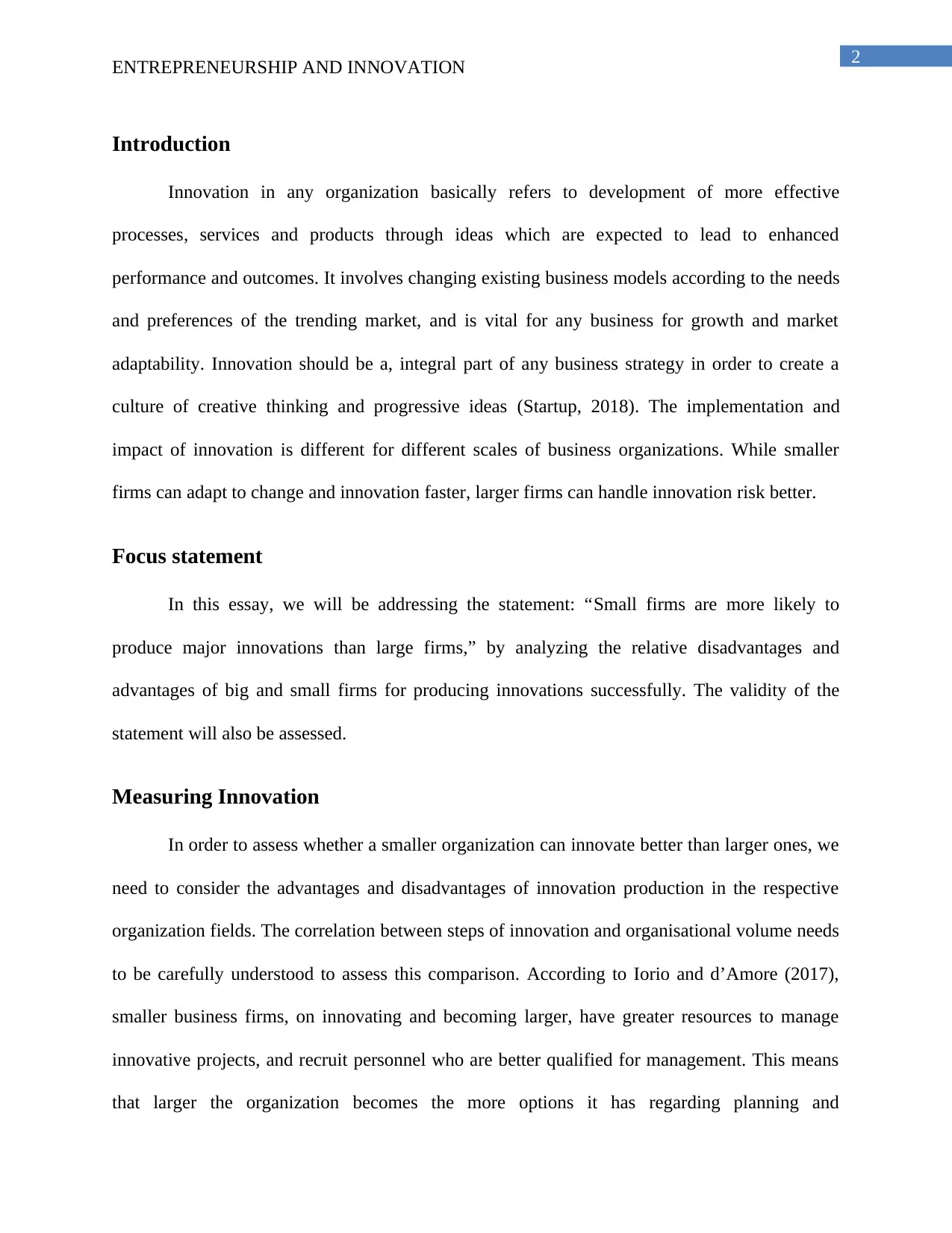
2
ENTREPRENEURSHIP AND INNOVATION
Introduction
Innovation in any organization basically refers to development of more effective
processes, services and products through ideas which are expected to lead to enhanced
performance and outcomes. It involves changing existing business models according to the needs
and preferences of the trending market, and is vital for any business for growth and market
adaptability. Innovation should be a, integral part of any business strategy in order to create a
culture of creative thinking and progressive ideas (Startup, 2018). The implementation and
impact of innovation is different for different scales of business organizations. While smaller
firms can adapt to change and innovation faster, larger firms can handle innovation risk better.
Focus statement
In this essay, we will be addressing the statement: “Small firms are more likely to
produce major innovations than large firms,” by analyzing the relative disadvantages and
advantages of big and small firms for producing innovations successfully. The validity of the
statement will also be assessed.
Measuring Innovation
In order to assess whether a smaller organization can innovate better than larger ones, we
need to consider the advantages and disadvantages of innovation production in the respective
organization fields. The correlation between steps of innovation and organisational volume needs
to be carefully understood to assess this comparison. According to Iorio and d’Amore (2017),
smaller business firms, on innovating and becoming larger, have greater resources to manage
innovative projects, and recruit personnel who are better qualified for management. This means
that larger the organization becomes the more options it has regarding planning and
ENTREPRENEURSHIP AND INNOVATION
Introduction
Innovation in any organization basically refers to development of more effective
processes, services and products through ideas which are expected to lead to enhanced
performance and outcomes. It involves changing existing business models according to the needs
and preferences of the trending market, and is vital for any business for growth and market
adaptability. Innovation should be a, integral part of any business strategy in order to create a
culture of creative thinking and progressive ideas (Startup, 2018). The implementation and
impact of innovation is different for different scales of business organizations. While smaller
firms can adapt to change and innovation faster, larger firms can handle innovation risk better.
Focus statement
In this essay, we will be addressing the statement: “Small firms are more likely to
produce major innovations than large firms,” by analyzing the relative disadvantages and
advantages of big and small firms for producing innovations successfully. The validity of the
statement will also be assessed.
Measuring Innovation
In order to assess whether a smaller organization can innovate better than larger ones, we
need to consider the advantages and disadvantages of innovation production in the respective
organization fields. The correlation between steps of innovation and organisational volume needs
to be carefully understood to assess this comparison. According to Iorio and d’Amore (2017),
smaller business firms, on innovating and becoming larger, have greater resources to manage
innovative projects, and recruit personnel who are better qualified for management. This means
that larger the organization becomes the more options it has regarding planning and
⊘ This is a preview!⊘
Do you want full access?
Subscribe today to unlock all pages.

Trusted by 1+ million students worldwide
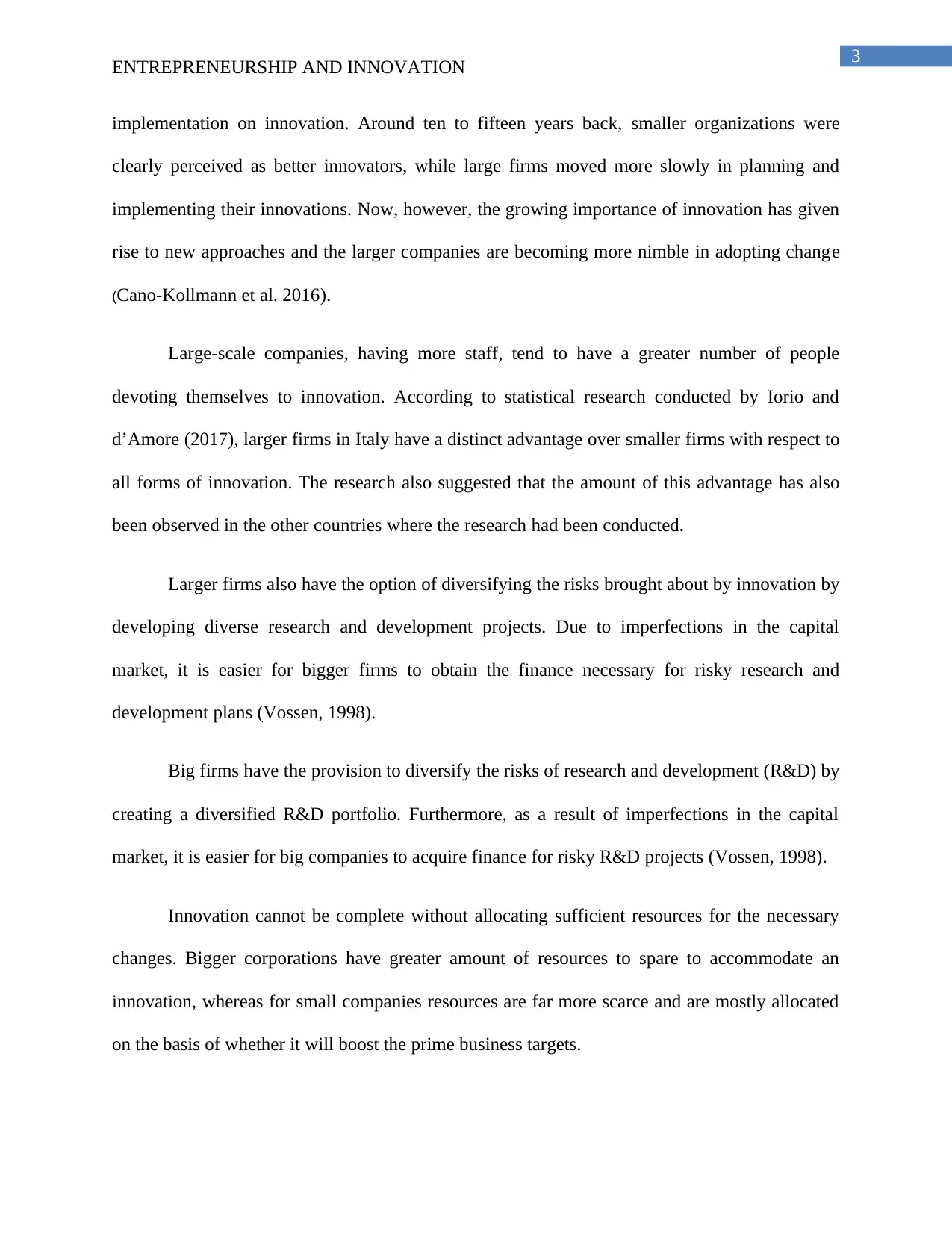
3
ENTREPRENEURSHIP AND INNOVATION
implementation on innovation. Around ten to fifteen years back, smaller organizations were
clearly perceived as better innovators, while large firms moved more slowly in planning and
implementing their innovations. Now, however, the growing importance of innovation has given
rise to new approaches and the larger companies are becoming more nimble in adopting change
(Cano-Kollmann et al. 2016).
Large-scale companies, having more staff, tend to have a greater number of people
devoting themselves to innovation. According to statistical research conducted by Iorio and
d’Amore (2017), larger firms in Italy have a distinct advantage over smaller firms with respect to
all forms of innovation. The research also suggested that the amount of this advantage has also
been observed in the other countries where the research had been conducted.
Larger firms also have the option of diversifying the risks brought about by innovation by
developing diverse research and development projects. Due to imperfections in the capital
market, it is easier for bigger firms to obtain the finance necessary for risky research and
development plans (Vossen, 1998).
Big firms have the provision to diversify the risks of research and development (R&D) by
creating a diversified R&D portfolio. Furthermore, as a result of imperfections in the capital
market, it is easier for big companies to acquire finance for risky R&D projects (Vossen, 1998).
Innovation cannot be complete without allocating sufficient resources for the necessary
changes. Bigger corporations have greater amount of resources to spare to accommodate an
innovation, whereas for small companies resources are far more scarce and are mostly allocated
on the basis of whether it will boost the prime business targets.
ENTREPRENEURSHIP AND INNOVATION
implementation on innovation. Around ten to fifteen years back, smaller organizations were
clearly perceived as better innovators, while large firms moved more slowly in planning and
implementing their innovations. Now, however, the growing importance of innovation has given
rise to new approaches and the larger companies are becoming more nimble in adopting change
(Cano-Kollmann et al. 2016).
Large-scale companies, having more staff, tend to have a greater number of people
devoting themselves to innovation. According to statistical research conducted by Iorio and
d’Amore (2017), larger firms in Italy have a distinct advantage over smaller firms with respect to
all forms of innovation. The research also suggested that the amount of this advantage has also
been observed in the other countries where the research had been conducted.
Larger firms also have the option of diversifying the risks brought about by innovation by
developing diverse research and development projects. Due to imperfections in the capital
market, it is easier for bigger firms to obtain the finance necessary for risky research and
development plans (Vossen, 1998).
Big firms have the provision to diversify the risks of research and development (R&D) by
creating a diversified R&D portfolio. Furthermore, as a result of imperfections in the capital
market, it is easier for big companies to acquire finance for risky R&D projects (Vossen, 1998).
Innovation cannot be complete without allocating sufficient resources for the necessary
changes. Bigger corporations have greater amount of resources to spare to accommodate an
innovation, whereas for small companies resources are far more scarce and are mostly allocated
on the basis of whether it will boost the prime business targets.
Paraphrase This Document
Need a fresh take? Get an instant paraphrase of this document with our AI Paraphraser
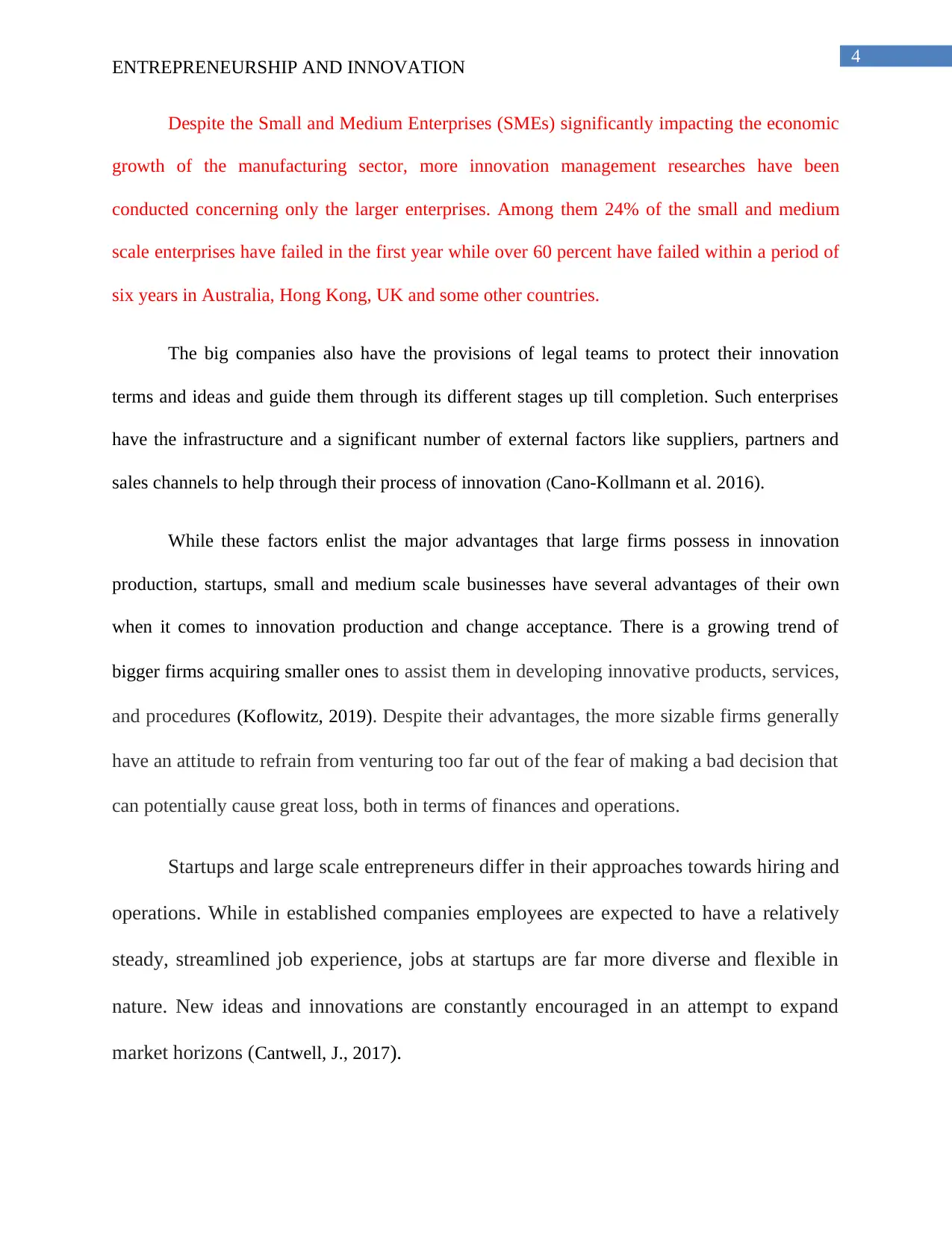
4
ENTREPRENEURSHIP AND INNOVATION
Despite the Small and Medium Enterprises (SMEs) significantly impacting the economic
growth of the manufacturing sector, more innovation management researches have been
conducted concerning only the larger enterprises. Among them 24% of the small and medium
scale enterprises have failed in the first year while over 60 percent have failed within a period of
six years in Australia, Hong Kong, UK and some other countries.
The big companies also have the provisions of legal teams to protect their innovation
terms and ideas and guide them through its different stages up till completion. Such enterprises
have the infrastructure and a significant number of external factors like suppliers, partners and
sales channels to help through their process of innovation (Cano-Kollmann et al. 2016).
While these factors enlist the major advantages that large firms possess in innovation
production, startups, small and medium scale businesses have several advantages of their own
when it comes to innovation production and change acceptance. There is a growing trend of
bigger firms acquiring smaller ones to assist them in developing innovative products, services,
and procedures (Koflowitz, 2019). Despite their advantages, the more sizable firms generally
have an attitude to refrain from venturing too far out of the fear of making a bad decision that
can potentially cause great loss, both in terms of finances and operations.
Startups and large scale entrepreneurs differ in their approaches towards hiring and
operations. While in established companies employees are expected to have a relatively
steady, streamlined job experience, jobs at startups are far more diverse and flexible in
nature. New ideas and innovations are constantly encouraged in an attempt to expand
market horizons (Cantwell, J., 2017).
ENTREPRENEURSHIP AND INNOVATION
Despite the Small and Medium Enterprises (SMEs) significantly impacting the economic
growth of the manufacturing sector, more innovation management researches have been
conducted concerning only the larger enterprises. Among them 24% of the small and medium
scale enterprises have failed in the first year while over 60 percent have failed within a period of
six years in Australia, Hong Kong, UK and some other countries.
The big companies also have the provisions of legal teams to protect their innovation
terms and ideas and guide them through its different stages up till completion. Such enterprises
have the infrastructure and a significant number of external factors like suppliers, partners and
sales channels to help through their process of innovation (Cano-Kollmann et al. 2016).
While these factors enlist the major advantages that large firms possess in innovation
production, startups, small and medium scale businesses have several advantages of their own
when it comes to innovation production and change acceptance. There is a growing trend of
bigger firms acquiring smaller ones to assist them in developing innovative products, services,
and procedures (Koflowitz, 2019). Despite their advantages, the more sizable firms generally
have an attitude to refrain from venturing too far out of the fear of making a bad decision that
can potentially cause great loss, both in terms of finances and operations.
Startups and large scale entrepreneurs differ in their approaches towards hiring and
operations. While in established companies employees are expected to have a relatively
steady, streamlined job experience, jobs at startups are far more diverse and flexible in
nature. New ideas and innovations are constantly encouraged in an attempt to expand
market horizons (Cantwell, J., 2017).
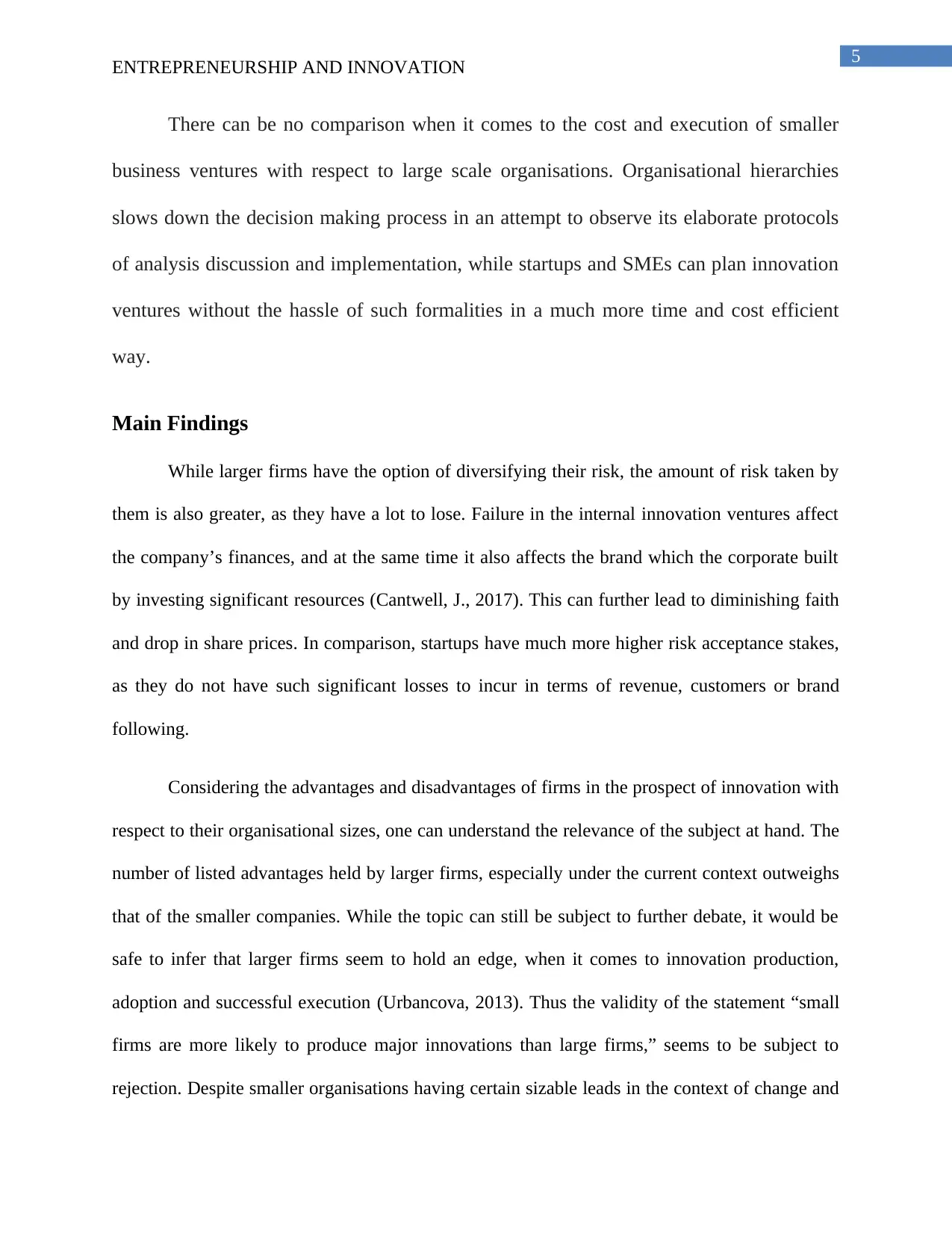
5
ENTREPRENEURSHIP AND INNOVATION
There can be no comparison when it comes to the cost and execution of smaller
business ventures with respect to large scale organisations. Organisational hierarchies
slows down the decision making process in an attempt to observe its elaborate protocols
of analysis discussion and implementation, while startups and SMEs can plan innovation
ventures without the hassle of such formalities in a much more time and cost efficient
way.
Main Findings
While larger firms have the option of diversifying their risk, the amount of risk taken by
them is also greater, as they have a lot to lose. Failure in the internal innovation ventures affect
the company’s finances, and at the same time it also affects the brand which the corporate built
by investing significant resources (Cantwell, J., 2017). This can further lead to diminishing faith
and drop in share prices. In comparison, startups have much more higher risk acceptance stakes,
as they do not have such significant losses to incur in terms of revenue, customers or brand
following.
Considering the advantages and disadvantages of firms in the prospect of innovation with
respect to their organisational sizes, one can understand the relevance of the subject at hand. The
number of listed advantages held by larger firms, especially under the current context outweighs
that of the smaller companies. While the topic can still be subject to further debate, it would be
safe to infer that larger firms seem to hold an edge, when it comes to innovation production,
adoption and successful execution (Urbancova, 2013). Thus the validity of the statement “small
firms are more likely to produce major innovations than large firms,” seems to be subject to
rejection. Despite smaller organisations having certain sizable leads in the context of change and
ENTREPRENEURSHIP AND INNOVATION
There can be no comparison when it comes to the cost and execution of smaller
business ventures with respect to large scale organisations. Organisational hierarchies
slows down the decision making process in an attempt to observe its elaborate protocols
of analysis discussion and implementation, while startups and SMEs can plan innovation
ventures without the hassle of such formalities in a much more time and cost efficient
way.
Main Findings
While larger firms have the option of diversifying their risk, the amount of risk taken by
them is also greater, as they have a lot to lose. Failure in the internal innovation ventures affect
the company’s finances, and at the same time it also affects the brand which the corporate built
by investing significant resources (Cantwell, J., 2017). This can further lead to diminishing faith
and drop in share prices. In comparison, startups have much more higher risk acceptance stakes,
as they do not have such significant losses to incur in terms of revenue, customers or brand
following.
Considering the advantages and disadvantages of firms in the prospect of innovation with
respect to their organisational sizes, one can understand the relevance of the subject at hand. The
number of listed advantages held by larger firms, especially under the current context outweighs
that of the smaller companies. While the topic can still be subject to further debate, it would be
safe to infer that larger firms seem to hold an edge, when it comes to innovation production,
adoption and successful execution (Urbancova, 2013). Thus the validity of the statement “small
firms are more likely to produce major innovations than large firms,” seems to be subject to
rejection. Despite smaller organisations having certain sizable leads in the context of change and
⊘ This is a preview!⊘
Do you want full access?
Subscribe today to unlock all pages.

Trusted by 1+ million students worldwide
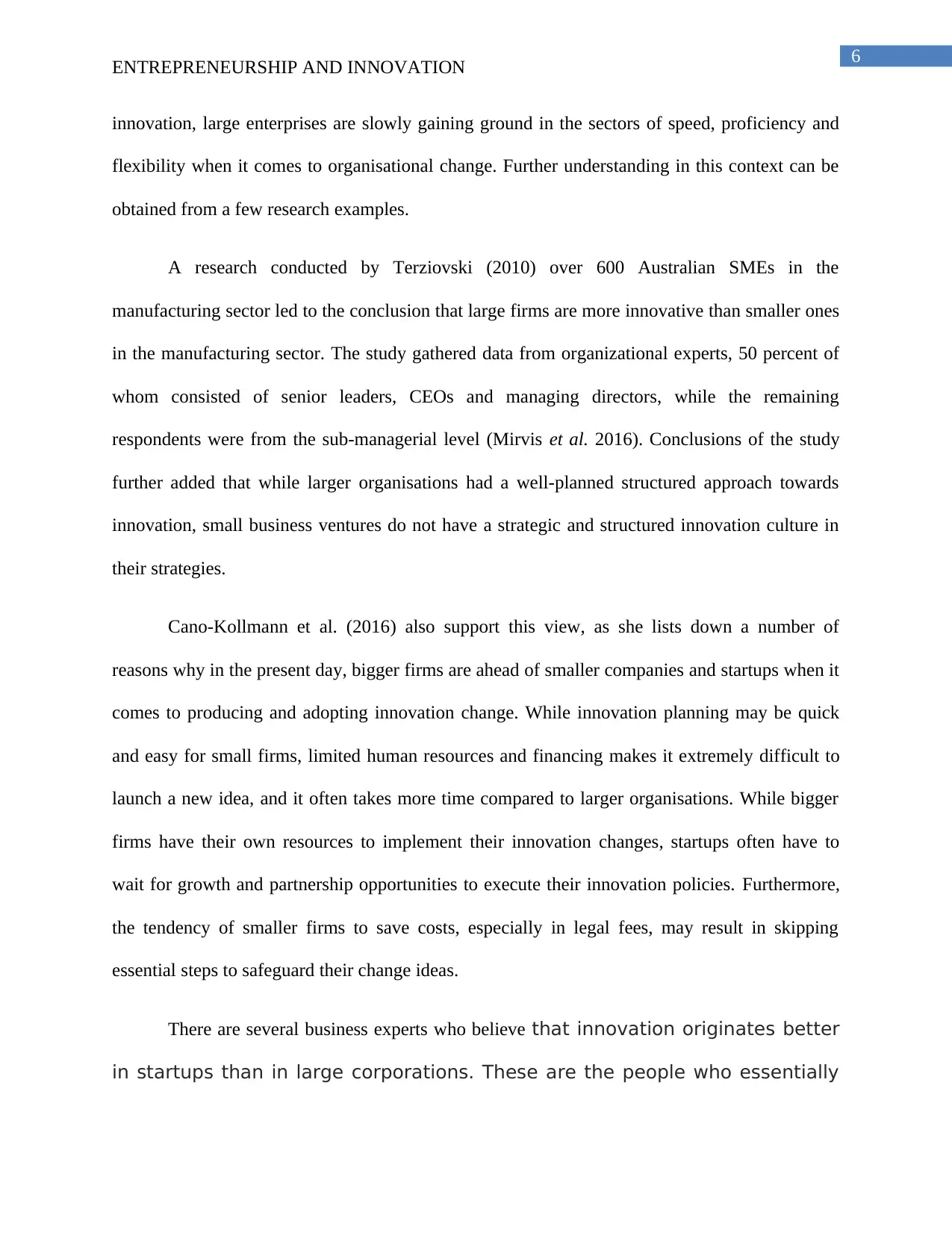
6
ENTREPRENEURSHIP AND INNOVATION
innovation, large enterprises are slowly gaining ground in the sectors of speed, proficiency and
flexibility when it comes to organisational change. Further understanding in this context can be
obtained from a few research examples.
A research conducted by Terziovski (2010) over 600 Australian SMEs in the
manufacturing sector led to the conclusion that large firms are more innovative than smaller ones
in the manufacturing sector. The study gathered data from organizational experts, 50 percent of
whom consisted of senior leaders, CEOs and managing directors, while the remaining
respondents were from the sub-managerial level (Mirvis et al. 2016). Conclusions of the study
further added that while larger organisations had a well-planned structured approach towards
innovation, small business ventures do not have a strategic and structured innovation culture in
their strategies.
Cano-Kollmann et al. (2016) also support this view, as she lists down a number of
reasons why in the present day, bigger firms are ahead of smaller companies and startups when it
comes to producing and adopting innovation change. While innovation planning may be quick
and easy for small firms, limited human resources and financing makes it extremely difficult to
launch a new idea, and it often takes more time compared to larger organisations. While bigger
firms have their own resources to implement their innovation changes, startups often have to
wait for growth and partnership opportunities to execute their innovation policies. Furthermore,
the tendency of smaller firms to save costs, especially in legal fees, may result in skipping
essential steps to safeguard their change ideas.
There are several business experts who believe that innovation originates better
in startups than in large corporations. These are the people who essentially
ENTREPRENEURSHIP AND INNOVATION
innovation, large enterprises are slowly gaining ground in the sectors of speed, proficiency and
flexibility when it comes to organisational change. Further understanding in this context can be
obtained from a few research examples.
A research conducted by Terziovski (2010) over 600 Australian SMEs in the
manufacturing sector led to the conclusion that large firms are more innovative than smaller ones
in the manufacturing sector. The study gathered data from organizational experts, 50 percent of
whom consisted of senior leaders, CEOs and managing directors, while the remaining
respondents were from the sub-managerial level (Mirvis et al. 2016). Conclusions of the study
further added that while larger organisations had a well-planned structured approach towards
innovation, small business ventures do not have a strategic and structured innovation culture in
their strategies.
Cano-Kollmann et al. (2016) also support this view, as she lists down a number of
reasons why in the present day, bigger firms are ahead of smaller companies and startups when it
comes to producing and adopting innovation change. While innovation planning may be quick
and easy for small firms, limited human resources and financing makes it extremely difficult to
launch a new idea, and it often takes more time compared to larger organisations. While bigger
firms have their own resources to implement their innovation changes, startups often have to
wait for growth and partnership opportunities to execute their innovation policies. Furthermore,
the tendency of smaller firms to save costs, especially in legal fees, may result in skipping
essential steps to safeguard their change ideas.
There are several business experts who believe that innovation originates better
in startups than in large corporations. These are the people who essentially
Paraphrase This Document
Need a fresh take? Get an instant paraphrase of this document with our AI Paraphraser
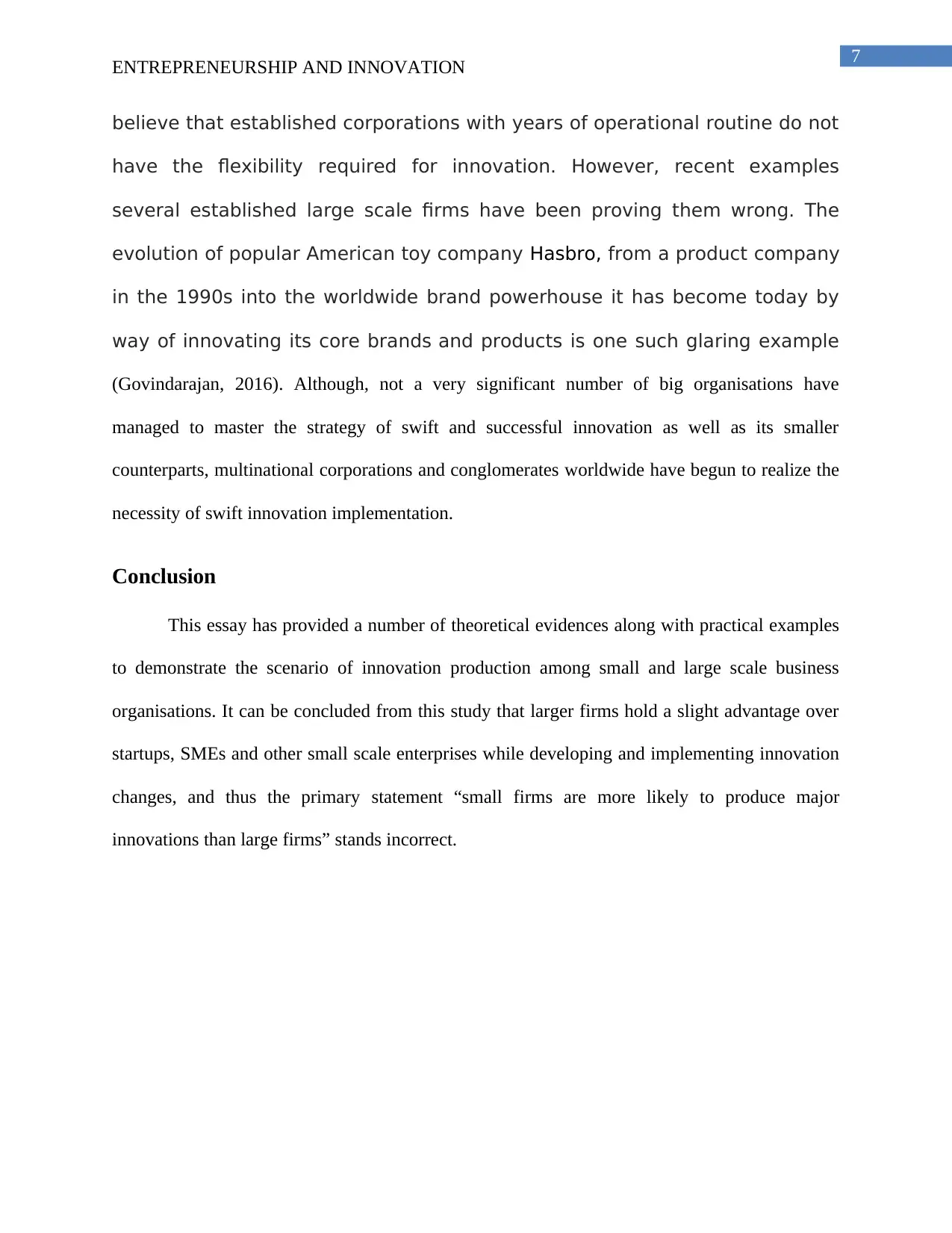
7
ENTREPRENEURSHIP AND INNOVATION
believe that established corporations with years of operational routine do not
have the flexibility required for innovation. However, recent examples
several established large scale firms have been proving them wrong. The
evolution of popular American toy company Hasbro, from a product company
in the 1990s into the worldwide brand powerhouse it has become today by
way of innovating its core brands and products is one such glaring example
(Govindarajan, 2016). Although, not a very significant number of big organisations have
managed to master the strategy of swift and successful innovation as well as its smaller
counterparts, multinational corporations and conglomerates worldwide have begun to realize the
necessity of swift innovation implementation.
Conclusion
This essay has provided a number of theoretical evidences along with practical examples
to demonstrate the scenario of innovation production among small and large scale business
organisations. It can be concluded from this study that larger firms hold a slight advantage over
startups, SMEs and other small scale enterprises while developing and implementing innovation
changes, and thus the primary statement “small firms are more likely to produce major
innovations than large firms” stands incorrect.
ENTREPRENEURSHIP AND INNOVATION
believe that established corporations with years of operational routine do not
have the flexibility required for innovation. However, recent examples
several established large scale firms have been proving them wrong. The
evolution of popular American toy company Hasbro, from a product company
in the 1990s into the worldwide brand powerhouse it has become today by
way of innovating its core brands and products is one such glaring example
(Govindarajan, 2016). Although, not a very significant number of big organisations have
managed to master the strategy of swift and successful innovation as well as its smaller
counterparts, multinational corporations and conglomerates worldwide have begun to realize the
necessity of swift innovation implementation.
Conclusion
This essay has provided a number of theoretical evidences along with practical examples
to demonstrate the scenario of innovation production among small and large scale business
organisations. It can be concluded from this study that larger firms hold a slight advantage over
startups, SMEs and other small scale enterprises while developing and implementing innovation
changes, and thus the primary statement “small firms are more likely to produce major
innovations than large firms” stands incorrect.
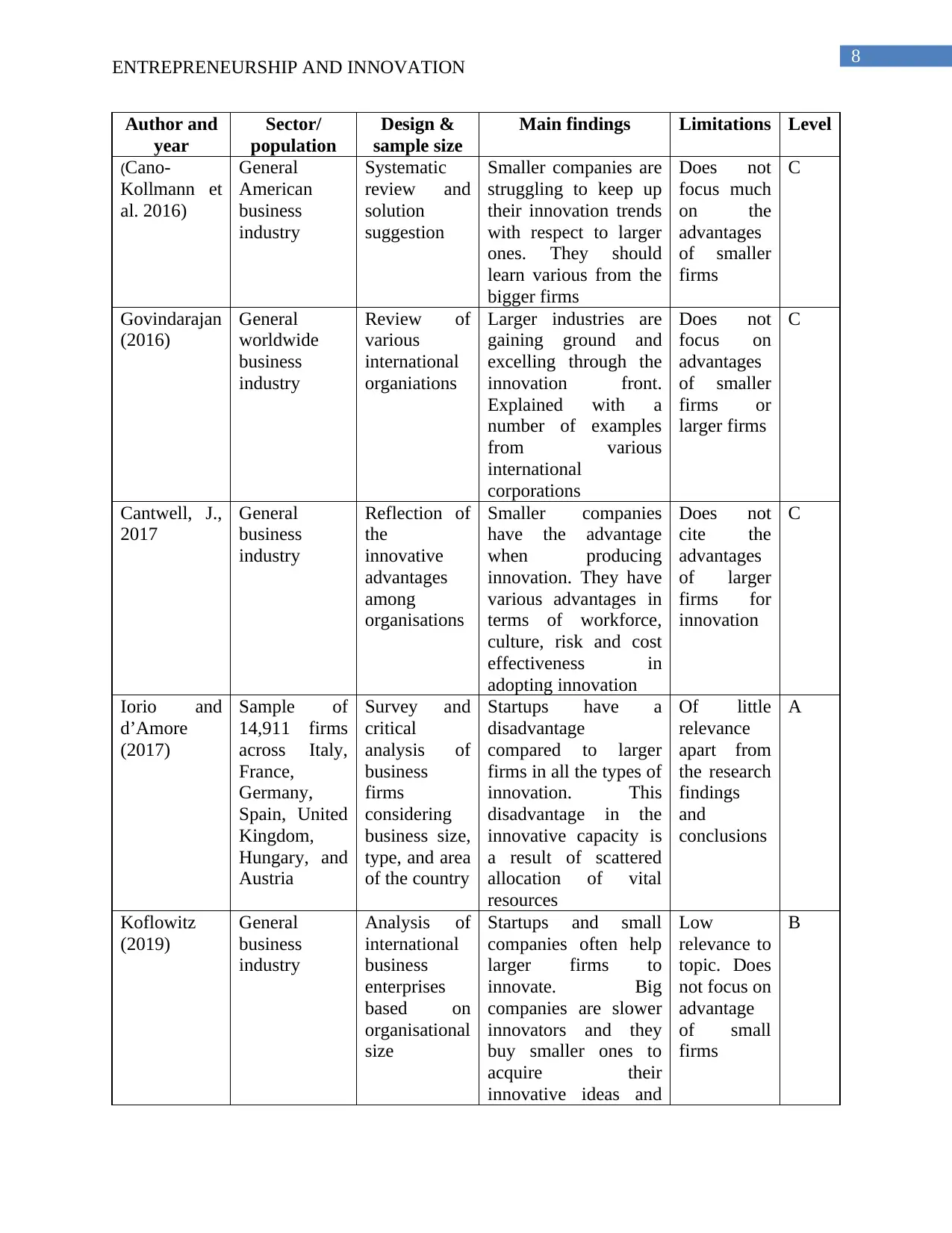
8
ENTREPRENEURSHIP AND INNOVATION
Author and
year
Sector/
population
Design &
sample size
Main findings Limitations Level
(Cano-
Kollmann et
al. 2016)
General
American
business
industry
Systematic
review and
solution
suggestion
Smaller companies are
struggling to keep up
their innovation trends
with respect to larger
ones. They should
learn various from the
bigger firms
Does not
focus much
on the
advantages
of smaller
firms
C
Govindarajan
(2016)
General
worldwide
business
industry
Review of
various
international
organiations
Larger industries are
gaining ground and
excelling through the
innovation front.
Explained with a
number of examples
from various
international
corporations
Does not
focus on
advantages
of smaller
firms or
larger firms
C
Cantwell, J.,
2017
General
business
industry
Reflection of
the
innovative
advantages
among
organisations
Smaller companies
have the advantage
when producing
innovation. They have
various advantages in
terms of workforce,
culture, risk and cost
effectiveness in
adopting innovation
Does not
cite the
advantages
of larger
firms for
innovation
C
Iorio and
d’Amore
(2017)
Sample of
14,911 firms
across Italy,
France,
Germany,
Spain, United
Kingdom,
Hungary, and
Austria
Survey and
critical
analysis of
business
firms
considering
business size,
type, and area
of the country
Startups have a
disadvantage
compared to larger
firms in all the types of
innovation. This
disadvantage in the
innovative capacity is
a result of scattered
allocation of vital
resources
Of little
relevance
apart from
the research
findings
and
conclusions
A
Koflowitz
(2019)
General
business
industry
Analysis of
international
business
enterprises
based on
organisational
size
Startups and small
companies often help
larger firms to
innovate. Big
companies are slower
innovators and they
buy smaller ones to
acquire their
innovative ideas and
Low
relevance to
topic. Does
not focus on
advantage
of small
firms
B
ENTREPRENEURSHIP AND INNOVATION
Author and
year
Sector/
population
Design &
sample size
Main findings Limitations Level
(Cano-
Kollmann et
al. 2016)
General
American
business
industry
Systematic
review and
solution
suggestion
Smaller companies are
struggling to keep up
their innovation trends
with respect to larger
ones. They should
learn various from the
bigger firms
Does not
focus much
on the
advantages
of smaller
firms
C
Govindarajan
(2016)
General
worldwide
business
industry
Review of
various
international
organiations
Larger industries are
gaining ground and
excelling through the
innovation front.
Explained with a
number of examples
from various
international
corporations
Does not
focus on
advantages
of smaller
firms or
larger firms
C
Cantwell, J.,
2017
General
business
industry
Reflection of
the
innovative
advantages
among
organisations
Smaller companies
have the advantage
when producing
innovation. They have
various advantages in
terms of workforce,
culture, risk and cost
effectiveness in
adopting innovation
Does not
cite the
advantages
of larger
firms for
innovation
C
Iorio and
d’Amore
(2017)
Sample of
14,911 firms
across Italy,
France,
Germany,
Spain, United
Kingdom,
Hungary, and
Austria
Survey and
critical
analysis of
business
firms
considering
business size,
type, and area
of the country
Startups have a
disadvantage
compared to larger
firms in all the types of
innovation. This
disadvantage in the
innovative capacity is
a result of scattered
allocation of vital
resources
Of little
relevance
apart from
the research
findings
and
conclusions
A
Koflowitz
(2019)
General
business
industry
Analysis of
international
business
enterprises
based on
organisational
size
Startups and small
companies often help
larger firms to
innovate. Big
companies are slower
innovators and they
buy smaller ones to
acquire their
innovative ideas and
Low
relevance to
topic. Does
not focus on
advantage
of small
firms
B
⊘ This is a preview!⊘
Do you want full access?
Subscribe today to unlock all pages.

Trusted by 1+ million students worldwide
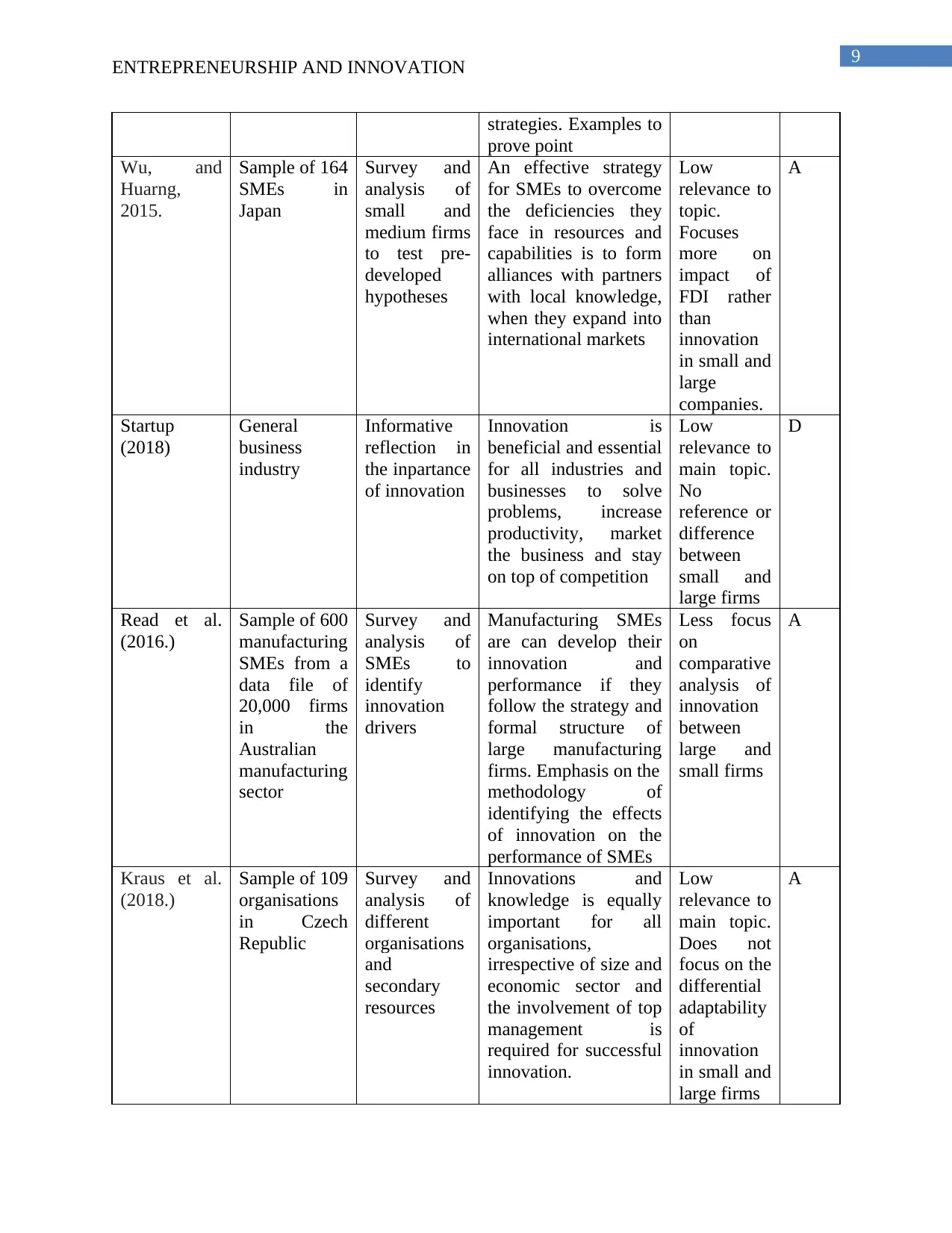
9
ENTREPRENEURSHIP AND INNOVATION
strategies. Examples to
prove point
Wu, and
Huarng,
2015.
Sample of 164
SMEs in
Japan
Survey and
analysis of
small and
medium firms
to test pre-
developed
hypotheses
An effective strategy
for SMEs to overcome
the deficiencies they
face in resources and
capabilities is to form
alliances with partners
with local knowledge,
when they expand into
international markets
Low
relevance to
topic.
Focuses
more on
impact of
FDI rather
than
innovation
in small and
large
companies.
A
Startup
(2018)
General
business
industry
Informative
reflection in
the inpartance
of innovation
Innovation is
beneficial and essential
for all industries and
businesses to solve
problems, increase
productivity, market
the business and stay
on top of competition
Low
relevance to
main topic.
No
reference or
difference
between
small and
large firms
D
Read et al.
(2016.)
Sample of 600
manufacturing
SMEs from a
data file of
20,000 firms
in the
Australian
manufacturing
sector
Survey and
analysis of
SMEs to
identify
innovation
drivers
Manufacturing SMEs
are can develop their
innovation and
performance if they
follow the strategy and
formal structure of
large manufacturing
firms. Emphasis on the
methodology of
identifying the effects
of innovation on the
performance of SMEs
Less focus
on
comparative
analysis of
innovation
between
large and
small firms
A
Kraus et al.
(2018.)
Sample of 109
organisations
in Czech
Republic
Survey and
analysis of
different
organisations
and
secondary
resources
Innovations and
knowledge is equally
important for all
organisations,
irrespective of size and
economic sector and
the involvement of top
management is
required for successful
innovation.
Low
relevance to
main topic.
Does not
focus on the
differential
adaptability
of
innovation
in small and
large firms
A
ENTREPRENEURSHIP AND INNOVATION
strategies. Examples to
prove point
Wu, and
Huarng,
2015.
Sample of 164
SMEs in
Japan
Survey and
analysis of
small and
medium firms
to test pre-
developed
hypotheses
An effective strategy
for SMEs to overcome
the deficiencies they
face in resources and
capabilities is to form
alliances with partners
with local knowledge,
when they expand into
international markets
Low
relevance to
topic.
Focuses
more on
impact of
FDI rather
than
innovation
in small and
large
companies.
A
Startup
(2018)
General
business
industry
Informative
reflection in
the inpartance
of innovation
Innovation is
beneficial and essential
for all industries and
businesses to solve
problems, increase
productivity, market
the business and stay
on top of competition
Low
relevance to
main topic.
No
reference or
difference
between
small and
large firms
D
Read et al.
(2016.)
Sample of 600
manufacturing
SMEs from a
data file of
20,000 firms
in the
Australian
manufacturing
sector
Survey and
analysis of
SMEs to
identify
innovation
drivers
Manufacturing SMEs
are can develop their
innovation and
performance if they
follow the strategy and
formal structure of
large manufacturing
firms. Emphasis on the
methodology of
identifying the effects
of innovation on the
performance of SMEs
Less focus
on
comparative
analysis of
innovation
between
large and
small firms
A
Kraus et al.
(2018.)
Sample of 109
organisations
in Czech
Republic
Survey and
analysis of
different
organisations
and
secondary
resources
Innovations and
knowledge is equally
important for all
organisations,
irrespective of size and
economic sector and
the involvement of top
management is
required for successful
innovation.
Low
relevance to
main topic.
Does not
focus on the
differential
adaptability
of
innovation
in small and
large firms
A
Paraphrase This Document
Need a fresh take? Get an instant paraphrase of this document with our AI Paraphraser

10
ENTREPRENEURSHIP AND INNOVATION
Vossen
(1998)
Analysis of
3M and
general
business
industry
Reflective
summary of
advantages of
small and
large firms in
innovation
Both small and large
organizations have
their own advantages
and disadvantages
depending on structure
and policies. Firms of
all sizes often
collaborate for mutual
innovational success
Does not
provide any
final
conclusion
whether
larger or
smaller
firms are
better at
innovation
A
ENTREPRENEURSHIP AND INNOVATION
Vossen
(1998)
Analysis of
3M and
general
business
industry
Reflective
summary of
advantages of
small and
large firms in
innovation
Both small and large
organizations have
their own advantages
and disadvantages
depending on structure
and policies. Firms of
all sizes often
collaborate for mutual
innovational success
Does not
provide any
final
conclusion
whether
larger or
smaller
firms are
better at
innovation
A
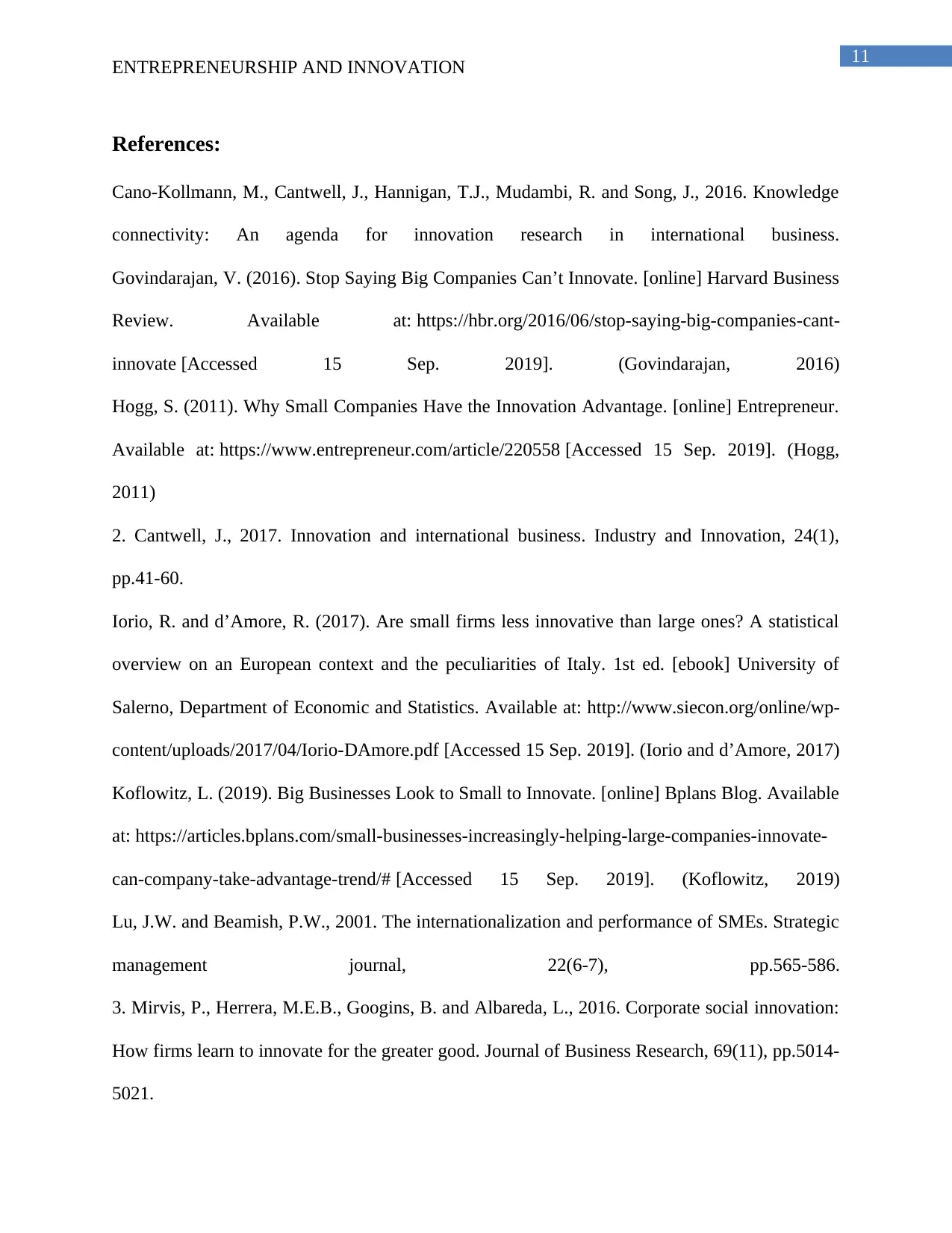
11
ENTREPRENEURSHIP AND INNOVATION
References:
Cano-Kollmann, M., Cantwell, J., Hannigan, T.J., Mudambi, R. and Song, J., 2016. Knowledge
connectivity: An agenda for innovation research in international business.
Govindarajan, V. (2016). Stop Saying Big Companies Can’t Innovate. [online] Harvard Business
Review. Available at: https://hbr.org/2016/06/stop-saying-big-companies-cant-
innovate [Accessed 15 Sep. 2019]. (Govindarajan, 2016)
Hogg, S. (2011). Why Small Companies Have the Innovation Advantage. [online] Entrepreneur.
Available at: https://www.entrepreneur.com/article/220558 [Accessed 15 Sep. 2019]. (Hogg,
2011)
2. Cantwell, J., 2017. Innovation and international business. Industry and Innovation, 24(1),
pp.41-60.
Iorio, R. and d’Amore, R. (2017). Are small firms less innovative than large ones? A statistical
overview on an European context and the peculiarities of Italy. 1st ed. [ebook] University of
Salerno, Department of Economic and Statistics. Available at: http://www.siecon.org/online/wp-
content/uploads/2017/04/Iorio-DAmore.pdf [Accessed 15 Sep. 2019]. (Iorio and d’Amore, 2017)
Koflowitz, L. (2019). Big Businesses Look to Small to Innovate. [online] Bplans Blog. Available
at: https://articles.bplans.com/small-businesses-increasingly-helping-large-companies-innovate-
can-company-take-advantage-trend/# [Accessed 15 Sep. 2019]. (Koflowitz, 2019)
Lu, J.W. and Beamish, P.W., 2001. The internationalization and performance of SMEs. Strategic
management journal, 22(6‐7), pp.565-586.
3. Mirvis, P., Herrera, M.E.B., Googins, B. and Albareda, L., 2016. Corporate social innovation:
How firms learn to innovate for the greater good. Journal of Business Research, 69(11), pp.5014-
5021.
ENTREPRENEURSHIP AND INNOVATION
References:
Cano-Kollmann, M., Cantwell, J., Hannigan, T.J., Mudambi, R. and Song, J., 2016. Knowledge
connectivity: An agenda for innovation research in international business.
Govindarajan, V. (2016). Stop Saying Big Companies Can’t Innovate. [online] Harvard Business
Review. Available at: https://hbr.org/2016/06/stop-saying-big-companies-cant-
innovate [Accessed 15 Sep. 2019]. (Govindarajan, 2016)
Hogg, S. (2011). Why Small Companies Have the Innovation Advantage. [online] Entrepreneur.
Available at: https://www.entrepreneur.com/article/220558 [Accessed 15 Sep. 2019]. (Hogg,
2011)
2. Cantwell, J., 2017. Innovation and international business. Industry and Innovation, 24(1),
pp.41-60.
Iorio, R. and d’Amore, R. (2017). Are small firms less innovative than large ones? A statistical
overview on an European context and the peculiarities of Italy. 1st ed. [ebook] University of
Salerno, Department of Economic and Statistics. Available at: http://www.siecon.org/online/wp-
content/uploads/2017/04/Iorio-DAmore.pdf [Accessed 15 Sep. 2019]. (Iorio and d’Amore, 2017)
Koflowitz, L. (2019). Big Businesses Look to Small to Innovate. [online] Bplans Blog. Available
at: https://articles.bplans.com/small-businesses-increasingly-helping-large-companies-innovate-
can-company-take-advantage-trend/# [Accessed 15 Sep. 2019]. (Koflowitz, 2019)
Lu, J.W. and Beamish, P.W., 2001. The internationalization and performance of SMEs. Strategic
management journal, 22(6‐7), pp.565-586.
3. Mirvis, P., Herrera, M.E.B., Googins, B. and Albareda, L., 2016. Corporate social innovation:
How firms learn to innovate for the greater good. Journal of Business Research, 69(11), pp.5014-
5021.
⊘ This is a preview!⊘
Do you want full access?
Subscribe today to unlock all pages.

Trusted by 1+ million students worldwide
1 out of 13
Your All-in-One AI-Powered Toolkit for Academic Success.
+13062052269
info@desklib.com
Available 24*7 on WhatsApp / Email
![[object Object]](/_next/static/media/star-bottom.7253800d.svg)
Unlock your academic potential
Copyright © 2020–2025 A2Z Services. All Rights Reserved. Developed and managed by ZUCOL.

